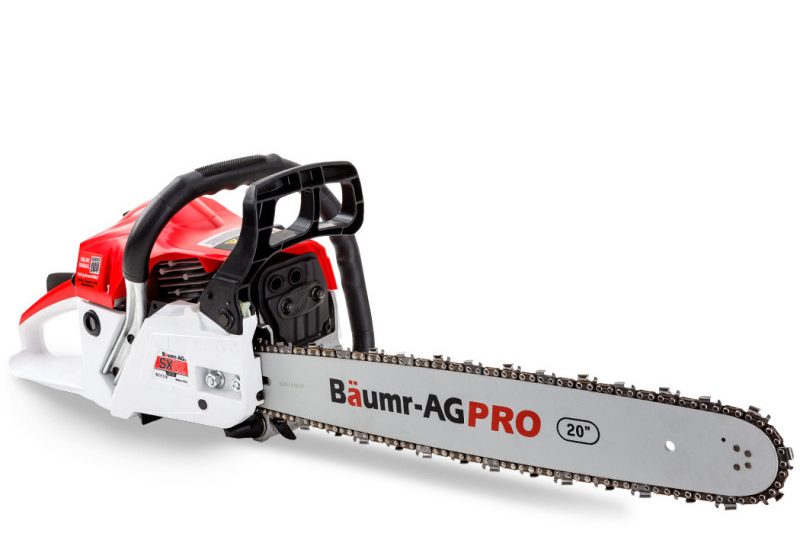Baumr-AG 52cc Chainsaw: Safe, Smart Use for Every Aussie
A practical, people-first guide for safe chainsaw use at home, on the farm, and in emergencies—real help for everyone, from beginners to bushfire crews.
Picture this: it’s late spring, grass is shooting up, and you’ve got limbs down from last night’s wind. Maybe you’re a family clearing a fence line, a renter prepping the yard, or a seasoned firefighter sizing up a firebreak. No matter where you live—bush, city, coast, or outback—the humble chainsaw is still one of the most useful (and potentially dangerous) tools you’ll own.
The Baumr-AG 52cc 20″ Bar E-Start Commercial Petrol Chainsaw SX52 has earned a spot in many Aussie sheds and fire trailers for a good reason—it’s gutsy, reliable, and tough enough for hard yakka, but it’s also light enough for the average person to manage. But—using any chainsaw safely takes more than muscle and good intentions. Whether you’re splitting firewood for winter, clearing after a storm, or working as part of a crew during fire season, knowing what to do (and what to avoid) can make all the difference.
This guide will walk you through everything you need to know—from prepping your Baumr-AG SX52 chainsaw, to practical cutting tips, essential safety, mistakes to dodge, and real stories from both backyard and fireground. You’ll also find gentle reminders for renters, families, pet owners, and anyone who wants to work smarter, not just harder. And if you’re looking to pick up this chainsaw for your own use, check out the Baumr-AG 52cc 20″ Bar E-Start Chainsaw here for more details.
How to Prepare: Safe Chainsaw Setup for Any Situation
Step 1: Know Your Tool—Why Prep Matters
Before you even think about starting your chainsaw, give yourself five minutes to get familiar. Read the manual (yes, even if you think you know it all!). For the Baumr-AG SX52, learn where the choke, primer, chain brake, fuel tank, and e-start button are. For families or first-time users: don’t rush this. One small detail can be the difference between an easy day’s work and a near miss.
Step 2: Get Your Safety Gear On
You might feel silly at first, but proper gear saves lives—full stop. Wear chainsaw chaps or pants, sturdy boots (preferably steel-capped), gloves, safety glasses, and hearing protection. For fire crews, a helmet with a face shield is standard, but even at home, goggles beat a stray chip to the eye any day. Remember: kids and pets well clear.
Step 3: Inspect, Fuel, and Test
Always check your chain tension, bar oil, and fuel mix before starting. With the Baumr-AG, you want the chain just snug, not too tight or loose. Fill up with fresh two-stroke mix (check the ratio in the manual), and don’t forget chain oil—it’s the lifeblood of the bar. Prime and test the e-start if it’s your first go for the day. If anything looks, smells, or sounds off, don’t risk it.
Smart Chainsaw Use: At Home, On the Farm, and On the Fireground
At Home & In the Backyard
Clearing up storm damage, trimming trees, or cutting firewood is bread-and-butter stuff. But here’s where most accidents happen—people get complacent, try to cut above shoulder height, or one-handed. Always keep both hands on the saw and stand firm. Don’t overreach or cut anything you can’t see clearly around. If you’re not sure, step back and rethink.
For renters, check your rental agreement—some won’t let you do major tree work, and you may be liable for any damage. If you’re in a unit or shared property, always notify neighbours before firing up the saw. Noise and flying chips travel!
Rural Properties & Bush Blocks
Living rural means more DIY, but also bigger risks—especially during fire season. Never use a chainsaw on a total fire ban day or when the bush is tinder-dry. For bush blocks, keep at least one person watching for sparks and have a hose or extinguisher handy. And don’t forget—blunt chains are a recipe for frustration and injury. Sharpen before you start, not after you’ve bogged it in a fallen log.
On the fireground, the chainsaw isn’t just for fallen trees—it’s often the tool that keeps a crew moving, opens up a track, or saves a life. But on a job like this, teamwork and communication matter even more than at home. Always assign a lookout, use radios if possible, and plan every cut. Even the best operators work slower when safety is at stake.
For Fire Crews and Emergency Teams
In the thick of a bushfire, a reliable chainsaw like the Baumr-AG SX52 can be a lifesaver—literally. Before deployment, run a full check: sharp chain, clean air filter, oiled bar, all safety features working. Never assume the last crew left it ready. After use, inspect everything again before packing it away.
If your team is split across multiple tasks, always account for the saws—know who has what, and make sure everyone is confident using them. A quick, calm toolbox talk at the start of shift can prevent drama later on.
After the Cut: Chainsaw Recovery, Maintenance & Clean-Up
Safe Shut-Down and Storage
Always let your chainsaw cool down before refuelling or packing away. Wipe down sawdust, check for loose bolts or leaks, and drain the tank if you’re putting it away for more than a week. For families, store the saw in a locked shed or toolbox—out of reach of kids and visitors.
Maintenance and Safety Checks
Regular maintenance is not just for pros. Even at home, make a habit of sharpening the chain, cleaning the bar groove, and inspecting the spark plug every few uses. If you’re not sure how, check your manual or watch a video from a trusted source. For the SX52, keep a basic toolkit and spare chain handy—you’ll thank yourself next time something gums up or breaks.
Looking After Your Crew (or Family)
Never leave a chainsaw running unattended, even for a moment. If you need a break, shut it down properly. Remind your crew, kids, or anyone around about safe zones—no one within two metres when the saw’s running. Accidents often happen when people rush or lose focus after a job’s done. Slow down, pack up properly, and check in with anyone who helped.
Chainsaw Packing & Planning Guide
- Chainsaw (with full fuel and bar oil)
- Sharpened spare chain and file
- Basic toolkit (screwdriver, spark plug spanner, multitool)
- First aid kit
- Gloves, eye and ear protection
- Fuel can (labelled, with correct 2-stroke mix)
- Chain oil bottle
- Clean rag or brush
- Radio or phone (for bush work or crews)
- Water and snacks (take a break!)
- Inspect chain, bar, and safety features
- Check fuel and oil levels
- Set up safe work zone (no kids, pets, or bystanders)
- Plan your cuts—avoid cutting above shoulder height
- Assign a spotter for larger jobs or crews
- Check local fire danger rating before starting
- Chainsaw and two spare chains (labelled by size)
- Full PPE: helmet, visor, gloves, chaps, boots
- Radio, spare batteries or charger
- Detailed map or navigation app (with offline access)
- Tag-out log or sign-in sheet for saw use
- Spare bar oil and 2-stroke fuel (never guess the mix!)
- Printed emergency contact and crew info
Tip: Double-check all gear before you leave base. On big firegrounds, lost or mixed-up gear can mean big delays or unsafe situations.
Mistakes to Avoid & Little-Known Chainsaw Wisdom
Common Pitfalls—What We See All the Time
- Forgetting PPE: “Just a quick cut” turns into stitches or worse
- Cutting with a dull chain (it’s slower and more dangerous)
- Poor footing: Slippery, uneven ground leads to slips and leg injuries
- One-handed operation: Never, no matter how “experienced”
- Not clearing the area—kids, pets, neighbours too close
- Poor maintenance: Dirty air filter, loose bolts, worn chain
- Trying to cut when tired, rushed, or upset
- Starting on a hot day or during fire bans—fire risk!
- Assuming everyone on the crew knows the same procedures
If you see any of these happening—pause, regroup, and reset. There’s no shame in stopping to check your setup. Real pros do it every time.
Voice of Experience
After years of helping people clean up after storms, I’ve learned that taking ten minutes to check the chain and walk the job site prevents hours of hassle later. On one fireground, a forgotten chain file meant we had to swap saws with another crew mid-job—costing us valuable time. It’s always the little things that catch you out.
Don’t be afraid to ask for help or admit you’re unsure—whether you’re new to chainsaws or firefighting. Most injuries happen when people are afraid to speak up or feel pressured to “just get on with it.”
Frequently Asked Questions
Absolutely, as long as you read the manual, use all safety gear, and start with simple tasks. The e-start is especially handy for those who struggle with pull cords. Just remember—if you’re unsure, ask someone with more experience to walk you through your first job.
Yes—it’s a good all-rounder for everything from splitting logs to clearing branches after a wild night. For heavy hardwood or long jobs, keep the chain sharp and have breaks. Always check local regulations for chainsaw use during fire bans.
The most common? No PPE, trying to cut one-handed, or using a blunt chain. Another big one is cutting while tired or rushed. Take your time, plan your cuts, and stay alert—especially if you’re working alone or with kids around.
Check the basics (chain, oil, air filter, bolts) before every job. Clean thoroughly and sharpen the chain every few uses. For heavy use or fireground work, a quick check after every session is smart. If you notice poor performance, odd noises, or leaking fuel, stop and inspect immediately.
Always tag in/out who’s using each saw, and make sure every operator is comfortable with the model. Run a quick “safety and function” check at the start of each shift. Share tips and checklists—no one is too experienced to skip the basics. Communication and teamwork keep everyone safer on the line.
You can, but always check your lease and talk with your landlord or property manager. Only do minor work you’re confident with, and never cut large trees or branches near power lines or structures. If in doubt, call in a pro.



